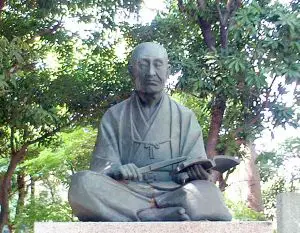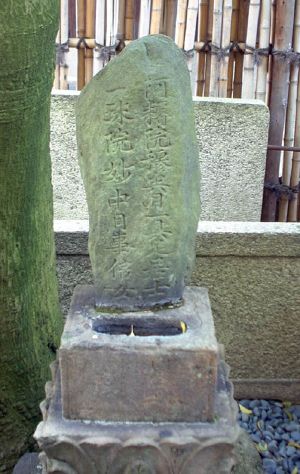Chikamatsu Monzaemon
Chikamatsu Monzaemon (Japanese: 近松門左衛門; real name Sugimori Nobumori, 杉森信盛, 1653–6 January 1725) was a Japanese dramatist of jōruri, the form of puppet theater that later came to be known as bunraku, and the live-actor drama, kabuki. Chikamatsu is known as the Japanese Shakespeare, for his assortment of plays staged by puppets in the early era of bunraku stage plays. He wrote plays mainly for theaters in Kyoto or Osaka, most of them notable for their double-suicides.
Biography
Chikamatsu was born "Sugimori Nobumori"[1] to a samurai family. It is disputable where he was born. The most supported theory [2], says he was born in Echizen province, but there are other candidates for his birthplace including Hagi, Nagato province. His father, Sugimori Nobuyoshi served the daimyo Matsudaira in Echizen as a medical doctor. Chikamatsu's younger brother became a medical doctor. Chikamatsu himself wrote a book for caring health.
In those days, doctors who served daimyos held samurai status. But his father lost his office and became a ronin. At some point in his teens, Chikamatsu moved to Kyoto with his father[3] where he served for a few years as a page for a noble family, but other than that, this period of Chikamatsu's life is obscure; he published his first known literary work in this period, a haiku published in 1671[3]. After serving as a page, he next appears in records in the Chikamatsu Temple (long suggested as the origin of his stage name "Chikamatsu") in Omi Province.
In 1683, his puppet play on the Soga brothers (The Soga Successors or "The Soga Heir"; Yotsugi Soga) was first performed in Kyoto and Chikamatsu became known as a playwright; The Soga Successors is believed to have been Chikamatsu's first play although sometimes 15 earlier anonymous plays are contended to have been by Chikamatsu as well. Chikamatsu also wrote plays for the kabuki theatre between 1684 and 1695, most of which were intended to be performed by a famous actor of the day, Sakata Tōjūrō (b. 1647, d. 1709).[1] After 1695, until 1705, almost everything Chikamatsu wrote was a Kabuki play, and then he abruptly almost completely abandoned that media. The exact reason is unknown, although speculation is rife: perhaps the puppets were more biddable and controllable than the ambitious kabuki actors, or perhaps Chikamatsu did not feel kabuki worth writing for since Tōjūrō was about to retire, or perhaps the growing popularity of the puppet theater was economically irresistible. In 1705, Chikamatsu became a "Staff Playwright" as announced by early editions of The Mirror of Craftsmen of the Emperor Yōmei. In 1706, Chikamatsu left Kyoto for Osaka, where the puppet theater was even more popular.[4] Chikamatsu's popularity peaked with his domestic plays of love-suicides, and with the blockbuster success of The Battles of Coxinga in 1715, but thereafter the tastes of patrons turned to more sensational gore-fests and otherwise more crude antics; Chikamatsu's plays would fall into disuse, so even the actual music would be lost for many plays.
Chikamatsu was the first known Japanese playwright to not also act in the pieces he wrote.[citation needed] Throughout his life it is thought that Chikamatsu wrote a total of around 130 plays.
Major works
Jōruri
- The Soga Successors or "The Soga Heir" (Yotsugi Soga) (1683)
- Kagekiyo Victorious (Shusse kagekiyo 出世景清) (1685)
- The Love Suicides at Sonezaki (Sonezaki shinjū 曾根崎心中) (1703)
- The Courier for Hell (Meido no hikyaku 冥途の飛脚) (1711)
- The Battles of Coxinga (Kokusen'ya kassen 国性爺合戦) (1715)
- The Uprooted Pine (Nebiki no Kadomatsu) (1718)
- The Love Suicides at Amijima (Shinjūten no Amijima 心中天網島) (1720)
- The Woman-Killer and the Hell of Oil (Onnagoroshi abura no jigoku 女殺油地獄) (1721)
Kabuki
- The Courtesan on Buddha Plain[1] (Keisei hotoke no hara けいせい仏の原) (1699)
See also
- Japanese literature
- List of Japanese authors
- Gagaku
ReferencesISBN links support NWE through referral fees
External links
es:Chikamatsu Monzaemon it:Chikamatsu Monzaemon ka:ტიკამაცუ მონძაემონ ja:近松門左衛門
Credits
New World Encyclopedia writers and editors rewrote and completed the Wikipedia article in accordance with New World Encyclopedia standards. This article abides by terms of the Creative Commons CC-by-sa 3.0 License (CC-by-sa), which may be used and disseminated with proper attribution. Credit is due under the terms of this license that can reference both the New World Encyclopedia contributors and the selfless volunteer contributors of the Wikimedia Foundation. To cite this article click here for a list of acceptable citing formats.The history of earlier contributions by wikipedians is accessible to researchers here:
The history of this article since it was imported to New World Encyclopedia:
Note: Some restrictions may apply to use of individual images which are separately licensed.

